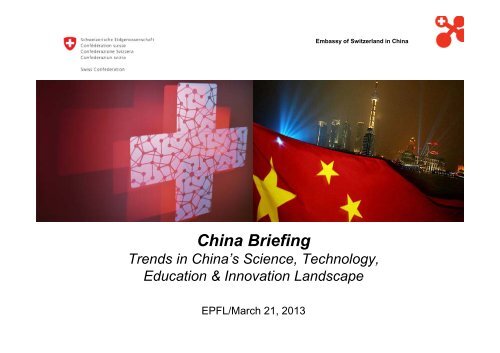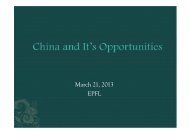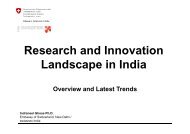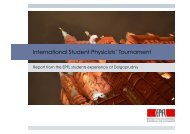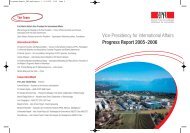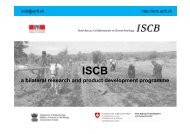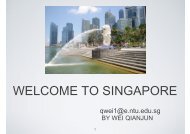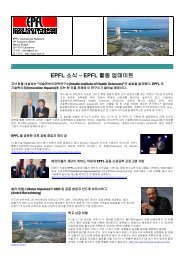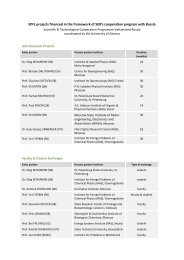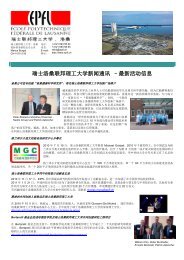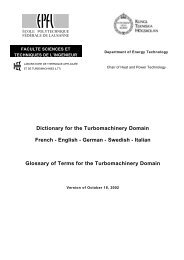Nektarios Palaskas - EPFL
Nektarios Palaskas - EPFL
Nektarios Palaskas - EPFL
You also want an ePaper? Increase the reach of your titles
YUMPU automatically turns print PDFs into web optimized ePapers that Google loves.
Embassy of Switzerland in China<br />
China Briefing<br />
Trends in China’s Science, Technology,<br />
Education & Innovation Landscape<br />
<strong>EPFL</strong>/March 21, 2013
Agenda<br />
• Government handover November 2012 – March 2013<br />
• STEI strategic frame-work in China<br />
• Goals within the Five Year Plans<br />
• China’s special focus / priorities<br />
2
Government handover November 2012 – March 2013<br />
• Government handover in the midst of STEI strategy plans<br />
• STEI governors, personal preferences and background<br />
• MoST merging with MoE and MIIT<br />
Reforms in STEI Governance<br />
3
STEI strategic frame-work in China<br />
• Long term strategy mapped out in a 15 year-plan<br />
Medium and Long-Term Science and Technology Development Plan 2006-2020<br />
• Education planning follows 10 year cycle<br />
Medium and Long-Term Education Development Plan 2010-2020<br />
• Short term are made every 5 years, based on long-term planning<br />
Five Year Plan for Science and Technology & Education Development 2011-2015<br />
• Complementary planning in STEI through State Council<br />
ad-hoc guidelines<br />
4
Goals within the Five Year Plans<br />
• Spur the development of an innovation-driven economy<br />
Shift from „made-in-China“ to „create-in-China“ thanks to indigenous innovation<br />
• Advancement of S&T for the benefit of economic growth<br />
55% of economic growth triggered by own S&T advancement (40% in 2011)<br />
High-tech sectors should account for 18% of total industrial growth (13% in 2011)<br />
5
Goals within the Five Year Plans<br />
• Reduce its dependence on foreign technologies<br />
Less 30% dependence on foreign Technologies (approx. 40% in 2011)<br />
Indicators: mega-sized space program, deep-sea expedition and supercomputer<br />
6
China’s special focus / priorities<br />
1. Growing investment in science and education sector<br />
2. Incentive packages to attract talents back to China<br />
3. Promote collaborative innovation<br />
4. International cooperation with Chinese Characteristics<br />
Opportunities for international cooperation?<br />
7
1. Growing investment in science and education sector<br />
8
1. Growing investment in science and education sector<br />
Project 985 & Project 211<br />
Country 1-100 101- 200 201- 300 301-400 401- 500 Number of<br />
Top 500<br />
Universities<br />
2011 China 0 1 6 5 11 23<br />
2010 China 0 2 5 3 12 22<br />
2009 China 0 0 6 2 10 18<br />
2008 China 0 0 6 1 11 18<br />
2007 China 0 1 5 2 6 13<br />
2006 China 0 1 4 2 2 8<br />
Jiaotong University Academic Performance Ranking<br />
9
1. Growing investment in science and education sector<br />
Unit: 1 million people<br />
25<br />
20<br />
15<br />
10<br />
5<br />
0<br />
15.6<br />
Number of Chinese Researchers, Bachelor Students and<br />
Graduate Students, 2005‐2010<br />
17.3<br />
18.8<br />
20.2<br />
21.4<br />
22.3<br />
1.36 1.5 1.73 1.96 2.29 2.55<br />
0.97 1.1 1.2 1.23 1.4 1.53<br />
No. of Researchers<br />
No. of bachelor students<br />
No. of graduate students<br />
2005 2006 2007 2008 2009 2010<br />
Source: China Science and Technology Statistics 2011<br />
China Education Statistics 2011<br />
10
2. Incentive packages to attract talents back to China<br />
• 2.24 million Chinese students with international education experience<br />
since 1978<br />
• „Thousand Talent Plan“ offering a generous package (including<br />
settlement stipend, starting research grant & easier access to S&T funds)<br />
• Local governments, universities and RI have launched their own talent<br />
incentive programs<br />
• Strong and growing fundings from Chinese universities & RIs indicate<br />
„fight for talents“ in the upcoming years<br />
11
3. Promote collaborative innovation<br />
• Collaborative innovation considered as general trend in STEI<br />
• Define roles for universities, research institutes and industries<br />
independent vs. joint research prorgams<br />
• Seven «strategic sectors» have been identified as a joint taks for<br />
academia and the industry by the Chinese Government:<br />
energy-saving & environmental protection, bio-technology, new energy,<br />
new materials, new vehicles, advanced equipment manufacturing and<br />
next generation information technology<br />
• Development of innovation-friendly infrastructure<br />
science & tech parks, joint labs, faculty exchange, entrepreneurship,<br />
student training, demonstration centers…<br />
12
4. International cooperation with Chinese Characteristics<br />
• International cooperation increasingly „China oriented“<br />
• Joint research centers are welcomed (preconditions)<br />
• MoE and MoST emphasize on long-term strategic partnerships<br />
• CAS as driving force for future cooperation (China vs. abroad)<br />
13
5. Define roles of universities and research institutes<br />
Figure 3: Central and Local Government S&T Appropriation in China (2000-2010)<br />
14
5. Define roles of universities and research institutes<br />
Figure 4: Expenditure on R&D by players (2010)<br />
15
Thank you for your attention!<br />
<strong>Nektarios</strong> <strong>Palaskas</strong><br />
Science & Technology Counsellor<br />
nektarios.palaskas@eda.admin.ch<br />
16


